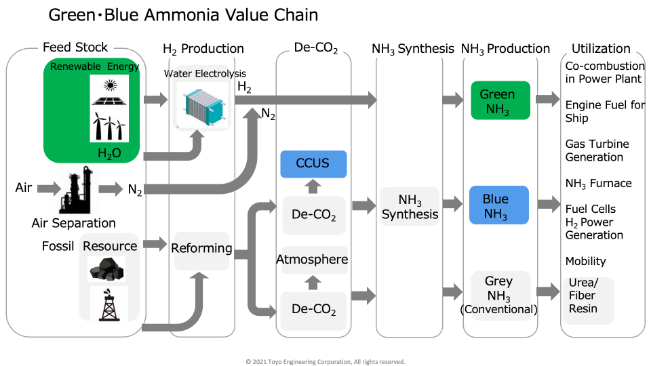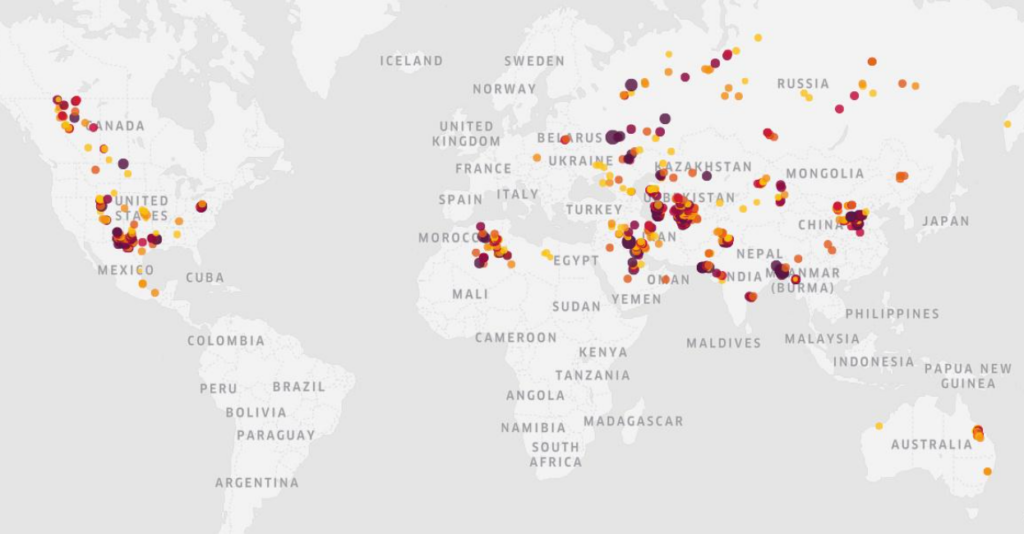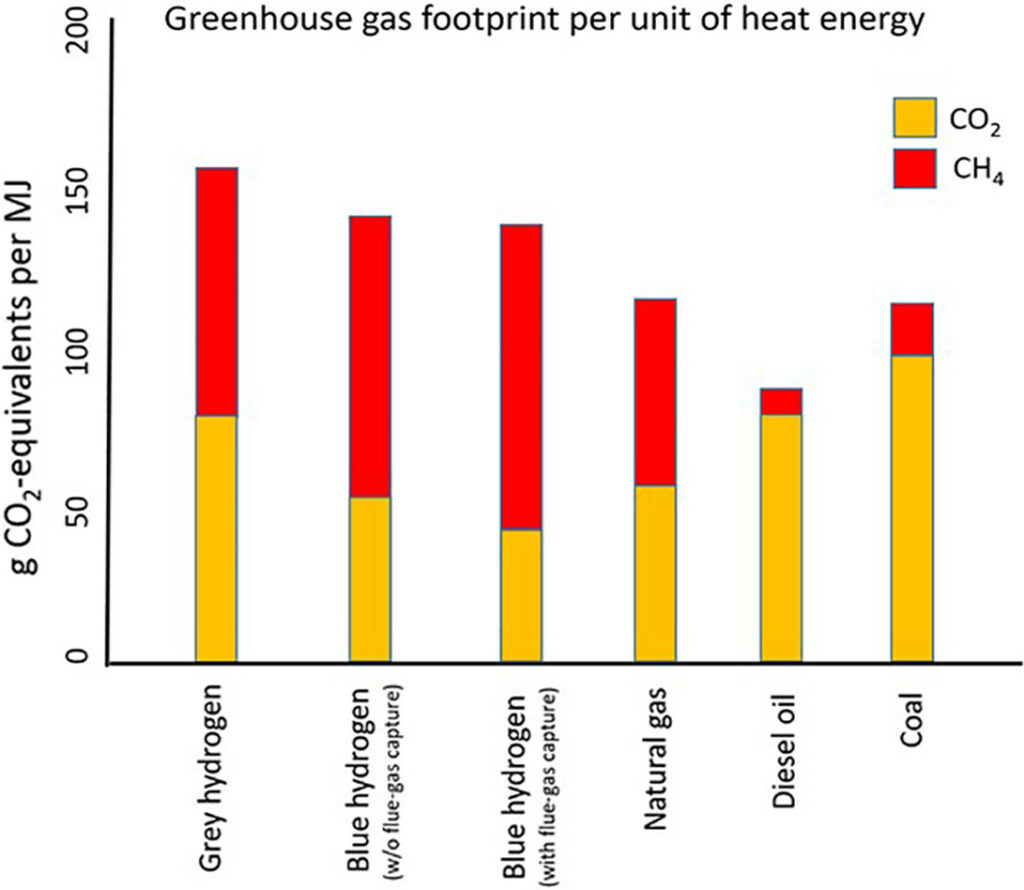Blue Ammonia Fuel: Usage, Projects and Future
17 August 2023 – by Eric Koons Comments (0)
Blue ammonia fuel is a much-debated alternative energy source. While some nations see blue ammonia fuel as a critical component of decarbonisation, others view it as a distraction from fully renewable options.
This debate is heating up on both sides as key industrial sectors arrive in the green energy transition spotlight. Hydrogen and ammonia have entered the ring as leading decarbonisation solutions for hard-to-decarbonise sectors like chemical, cement and fertiliser production.
Both solutions are still in development, yet they are seeing an increasing investment rate. If the International Renewable Energy Agency (IRENA) is correct, the global ammonia market will triple in size by 2050.
This supports several new markets for ammonia, such as its use as a hydrogen carrier and as fuel for stationary power plants and transport. However, this growth must be low-carbon to align with global climate commitments.
What Is Blue Ammonia Fuel?
Blue ammonia fuel is a potent energy carrier produced through a multi-step process that involves nitrogen and hydrogen. In this case, hydrogen primarily comes from natural gas through a process known as steam methane reforming.
Steam Methane Reforming
Steam methane reforming involves reacting methane (from natural gas) with steam under high temperatures to produce hydrogen, carbon monoxide and carbon dioxide. However, this process yields significant carbon dioxide emissions, posing a considerable environmental challenge. This is where the “blue” in “blue ammonia” comes into play.
Carbon Capture Technology
The “blue” denotes the carbon capture and storage (CCS) processes integrated into the production. In essence, CCS technology captures the CO2 emissions from steam methane reforming and stores it underground or underwater, preventing its release into the atmosphere.
What Is the Difference Between Blue Ammonia and Green Ammonia?
The difference between blue and green ammonia fuel lies primarily in the sourcing and production process of hydrogen. This dictates their respective environmental impacts.
Blue ammonia is produced by extracting hydrogen from natural gas. It relies on existing fossil fuel extraction, further development of extraction capacity and the construction of more fossil fuel infrastructure.
On the other hand, green ammonia production leverages hydrogen obtained through water electrolysis (green hydrogen) that is powered by renewable energy sources like solar or wind power. This process splits water molecules into hydrogen and oxygen, with the hydrogen then used for ammonia synthesis.
Unlike the blue variant, green ammonia production can be virtually carbon-free, assuming that the electricity used for electrolysis comes from renewable sources. This characteristic makes green ammonia a truly low-carbon fuel or even carbon-neutral energy carrier.

Is Blue Ammonia Sustainable?
Blue ammonia is not sustainable due to its reliance on natural gas. First, CCS is not perfect, and even though most projects target 90% of emissions, current projects have a much lower efficiency.
Additionally, the carbon intensity of CCS technology remains high so that the net carbon reduction will be much lower than direct capture rates.

Natural Gas Extraction and Carbon Dioxide Emissions
Meanwhile, natural gas extraction, transportation and initial processing contribute to greenhouse gas emissions. For CCS to be viable, it must address these potential release areas. Existing natural gas infrastructure in the US leaks 1.4% of all natural gas extracted in the country, equalling 8 million tonnes of methane annually.
Finally, blue ammonia perpetuates the ongoing extraction of fossil fuels, creating less incentive for countries to phase out fossil fuels entirely. Even if natural gas is only a short-term “transition fuel,” it slows down the overall energy transition that leading organisations continue to emphasise as necessary.
Blue Ammonia Projects: Japan Leads the Way
Despite the environmental concerns, a surge of blue ammonia fuel projects worldwide testifies to its perceived potential.
In Japan, the world’s first blue ammonia shipment from Saudi Aramco was received in 2020, signalling a shift in the country’s energy mix. However, the project is just the tip of the iceberg. Japan is considering implementing low-carbon ammonia with ammonia coal co-firing to keep its existing coal-fired power plant system online.
With numerous, similar initiatives underway, blue ammonia is gaining traction as an energy carrier across the region. Yet, the associated increase in CO2 emissions is a reminder of the need for alternative, genuinely sustainable solutions.
A Controversial Decarbonisation Strategy
While blue ammonia has emerged as a purported low-carbon energy source, its ties to fossil fuels undermine its role as a sustainable decarbonisation strategy. The process’ reliance on natural gas extraction and the limited efficiency of carbon capture technologies result in an understated carbon footprint.

Furthermore, a recent study found that blue hydrogen only produces 9-12% fewer emissions than grey hydrogen. This is a good surrogate for ammonia production, as most emissions are directly from hydrogen production. Blue ammonia does not significantly reduce emissions compared to ammonia production, which relies solely on fossil fuels without CCS.
This reinforces that as the energy landscape evolves, the focus should be on truly low-carbon solutions. Green ammonia stands out in this respect, offering the potential for an energy future that is not just lower-carbon but carbon-neutral.
The transition to a sustainable energy future must prioritise strategies that reduce carbon emissions to zero. As it stands, blue ammonia fails to meet this standard.
by Eric Koons
Eric is a passionate environmental advocate that believes renewable energy is a key piece in meeting the world’s growing energy demands. He received an environmental science degree from the University of California and has worked to promote environmentally and socially sustainable practices since. Eric’s expertise extends across the environmental field, yet he maintains a strong focus on renewable energy. His work has been featured by leading environmental organizations, such as World Resources Institute and Hitachi ABB Power Grids.
Read more